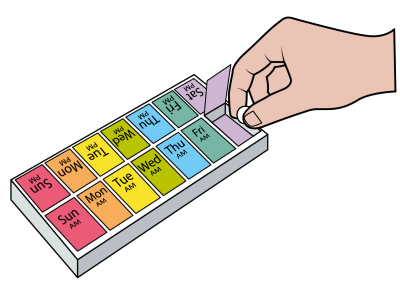After the diagnosis of a Stroke or a Transient Ischaemic Attack (TIA), you may start new medications, or your medications may be changed. There are some common types of medications that are prescribed following a stroke and this is dependent on the type of stroke you have.
‘Blood-thinning’ medications:
- Antiplatelets such as Aspirin or Clopidogrel are often prescribed if you have experienced an ischaemic stroke or a TIA (when an artery is blocked. They reduce your risk of a further artery blockage. Sometimes (and usually for a short period of time) you may be on a combination of antiplatelets.
- Anticoagulants such as Warfarin, Apixaban, Rivaroxaban, Edoxaban or Dabigatran may be prescribed if you have Atrial Fibrillation (AF). AF is a condition that causes a specific irregular heart rhythm and often abnormally fast heart rate. It can lead to a higher risk of ischaemic strokes, but anticoagulants will reduce this risk. On certain occasions they might be prescribed even if you don’t have AF.

Cholesterol lowering medications such as Statins (e.g. Atorvastatin, Simvastatin Rosuvastatin), Ezetimibe or (less often) Bempedoic Acid are prescribed for most people following an ischaemic stroke or TIA. They will prevent the development of atherosclerosis (damage in the inner part of the vessel wall) and hopefully reduce your future risk of stroke. A small proportion of patients with an ischaemic stroke may need further cholesterol lowering treatment with injectable medications.
Blood pressure lowering medications such as Perindopril and Amlodipine may be prescribed. High blood pressure is the biggest single risk factor for stroke and most often does not cause any daily symptoms; this means that regular blood pressure checks are important to ensure this is well controlled. Some patients will need a combination of blood pressure lowering medication.
To find out more information about medication you may be given after your stroke, you can read the leaflets created by the Stroke Association by clicking on the links below.
Blood Thinning Medication and Stroke Guide
High Blood Pressure and Stroke Guide
You can also read more information about high blood pressure and medication used to treat it on the British Heart Foundation website.
If you struggle to take your medications there are devices to help with this -speak to your GP, Pharmacy or Stroke rehab team for more information.
Your consultant and then GP will consider interactions between drugs when prescribing them to reduce adverse reactions. If any new medication is not agreeing with you, consult your GP who can look for an alternative medication or adjust your dose.
Taking the above medications after a stroke or TIA have been shown to reduce your risk of further stroke or cardiovascular events (e.g. heart attack). Also making changes to your lifestyle and more importantly maintaining these changes is a good way of reducing your risk to further strokes.
Common stroke risk factors include the following:
- High Blood Pressure
- Atrial Fibrillation
- Diabetes
- Raised Cholesterol
- Smoking
- Alcohol
- Being overweight
- Lack of exercise / sedentary lifestyle
- Unhealthy diet
See the website page on healthy lifestyles for further advice.
If you are on a low income, you may be able to receive financial help towards your prescription. The NHS have a low-income scheme to help people with prescription costs. You can apply for the scheme if your savings, investments or property (not including where you live) within the capital limit. If you live in a care home, the capital limit is £23,250. For everyone else, it is £16,000.
- For further information on help with prescription costs and to work out whether you are eligible, Healthwatch provide some useful advice.
- To find out how to apply for the low-income scheme and claim money back that you have already paid visit the NHS website.
- To apply for financial support with medications go to the government website.
Disclaimer
SOME MEDICATIONS CAN CAUSE SIDE EFFECTS: PLEASE SPEAK TO YOUR CONSULTANT, GP OR PHARMACIST IF YOU HAVE ANY CONCERNS.
LOTS OF MEDICATIONS CANNOT BE STOPPED SUDDENLY; THEY NEED TO BE REDUCED CAREFULLY.